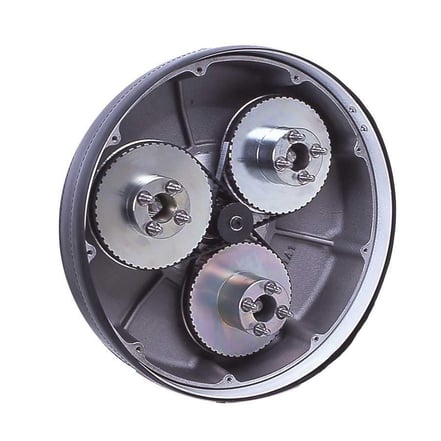When it comes to concrete resurfacing projects, there are a few common mistakes that you can easily avoid. Knowing what these potential blunders can help you plan and execute your project with confidence and ease.
In this article, we’ll go over the main pitfalls when it comes to concrete resurfacing – so you know what to look out for!
What Is Concrete Resurfacing?
Before diving into this article, let's examine what exactly concrete resurfaces is.
Simply put - concrete resurfacing is a process of repairing and transforming existing concrete surfaces. It involves the use of specialized products, such as concrete overlays, coatings, sealers, and patches, to restore concrete that has been affected by natural aging and deterioration.
But that's not all - concrete resurfacing can also be used to enhance the aesthetic appeal of an existing surface by changing its color, texture, and appearance.
Why Might Concrete Require Resurfacing?
Concrete can require resurfacing for several different reasons. In some cases, the existing concrete slab may show signs of wear and tear due to regular use or exposure to harsh weather conditions.
In other cases, it may be necessary to restore an aging concrete surface to keep it safe and attractive. In fact, according to HomeLight, well-maintained driveways can increase property value by $10,000 to $20,000.
.jpg?width=600&height=332&name=SW%20Ardmore%20Training%202%20(1).jpg)
Benefits of Having a Professionally Resurfaced Concrete Surface
There are many advantages to investing in professional concrete resurfacing.
One of the main benefits is that it can improve the overall aesthetic appeal of a space such as an old concrete patio, making it look more inviting and attractive. Stamped concrete and decorative overlays, for instance, are excellent for creating appealing aesthetics.
Professionally resurfaced surfaces are also more durable and resistant to wear and tear caused by regular use or harsh weather conditions. Moreover, resurfacing also helps to reduce maintenance costs, since the surface won't require frequent patching and repairs.
On top of that, in many cases, a concrete resurfacing costs less than the cost of replacing it. Concrete removal costs typically range from $2 to $6 per square foot. On the other hand, the cost of pouring a new concrete slab can range from $6 to $15 per square foot.
With that being said, the price per square foot would be about $8 just to tear out and replace your existing surface with a plain gray slab. Meanwhile,, the cost of a concrete resurfacing starts at about $3 per square foot, with cost increases based on the design.
Finally, professionally resurfaced concrete surfaces are generally considered to be safer because any irregularities in the surface can be filled in or smoothed out.
The Top 9 Common Mistakes to Avoid When Resurfacing Concrete
Although concrete resurfacing can offer many benefits, it's important to remember that resurfacing concrete is not a task that should be taken lightly. It requires skill and expertise, and if the process is not completed correctly, it can lead to costly mistakes.
Here are some top common mistakes to avoid when resurfacing concrete surfaces:
1. Choosing the Wrong Material for the Project
Not all concrete resurfacing materials are created equal, so it's important to choose one that is suited for the project at hand. If you use the wrong material for your project, the result may not be what you want. Worse, it may also fail to bond properly with the concrete, leading to premature cracking and peeling.
How Can I Avoid This?
The best way to avoid this mistake is to consult with a professional about concrete resurfacing options before any project. Experienced concrete specialists, such as the team at Onfloor, may be able to point you in the direction of the most suitable material for your project so you can ensure that the job is completed correctly.
Depending on what kind of look you're trying to achieve, there may be several different materials that can be used. For example, if you want a glossy finish, then a high-gloss sealer might be the best choice, whereas if you're looking for a matte finish, then an overlay might be more suitable.
2. Not Preparing the Surface Properly
Surface preparation is crucial for any concrete resurfacing project. This includes cleaning and repairing any cracks, holes, or spalling that may exist on the surface, such as a concrete driveway. Skipping this step can lead to poor results and may even cause further damage to the concrete.
How Can I Avoid This?
The best way to prep a concrete surface is to use a grinder or a power washer. This will remove any dirt, grime, or debris that may be present on the surface. Once the surface is clean and free of any imperfections, then it's time to apply the resurfacing material.
Onfloor's OF16S Floor Grinder is a great choice for tackling large-scale resurfacing projects. This multi-purpose machine can prep surfaces such as concrete decks, sand wood floors, and grind concrete efficiently.
3. Not Applying Enough Material
Another common mistake that can occur when resurfacing concrete is not applying enough material. Essentially, if you don’t apply enough material during resurfacing, the material won’t bond properly with the existing concrete, which could lead to peeling or cracking. This is especially true for overlay materials that must be applied in several thin layers.
How Can I Avoid This?
The best way to avoid this mistake is to properly measure the area you're resurfacing, allowing you to calculate how much material you will need for the job. It's also important to follow the manufacturer’s instructions for mixing and applying the product correctly.
4. Not Curing the Material Properly
It's essential to ensure that the resurfaced concrete is properly cured. Curing is an important step in any concrete resurfacing job, as it helps the material bond with the existing concrete and ensures a strong and durable result. If a material is not given enough time to cure, it can lead to peeling, cracking, and discoloration of the surface.
How Can I Avoid This?
The best way to avoid this mistake is to follow the manufacturer’s instructions for curing times and temperatures. As a general rule, it’s best to allow the material to cure for at least 24 hours before allowing foot traffic or other activities on the newly resurfaced concrete surface. This will help ensure that the job is done correctly and will lead to better results.
5. Underestimating the Complexity of the Job
Another mistake that can often be made during the resurfacing process is underestimating the complexity of the job. This is especially true with stamped and colored concrete, as these projects require more skill and expertise than a standard concrete overlay or sealer application.
Often, when contractors underestimate the complexity of a job, it can lead to many problems such as:
- Not laying the concrete on a consistent level
- Underestimating how much material is needed for the job
- Not allowing enough time or attention to detail for curing and finishing
- Not properly cleaning and prepping the surface before application

How Can I Avoid This?
The best way to avoid this mistake is to always consult with an experienced contractor before beginning any concrete resurfacing project. An experienced contractor will be able to advise you on the best techniques for completing your project and ensure that it is done correctly. This will help to avoid costly mistakes resulting from inadequate preparation or application of materials.
6. Not Adhering to Manufacturer Instructions
It's important to make sure that you adhere to the manufacturer’s instructions for any product you are using in a concrete resurfacing project. Each product is different and may require special conditions or techniques for application.
How Can I Avoid This?
The best way to avoid this mistake is to take the time to familiarize yourself with the products you are using. Additionally, it's important to work with experienced concrete professionals who can advise you on the products and machines you’re working with.
7. Not Applying a Sealer or Topcoat
It can be tempting to cut corners when performing a concrete resurfacing project, but taking shortcuts can often lead to poor results or even additional damage. With that being said, it's important to apply a sealer or topcoat to the finished concrete surface.
This will help protect the concrete slab from water damage, staining, and wear and tear. This protection is necessary for the resurfacing job to last as long as it should.
How Can I Avoid This?
The best way to avoid this mistake is to make following up a concrete resurfacing project with a sealer or topcoat an integral part of your process. Ensure that all contractors or subcontractors are aware of this step and that they include it in their initial cost estimate. Doing so can help to ensure a long-lasting and durable result.
8. Using Inferior Products or Tools
Another common mistake when resurfacing concrete surfaces is using inferior products or tools. This can lead to poor results and even further damage to the concrete. For example, using a poor-quality grinder to prep the surface may lead to uneven spots that are hard to fix after a new surface is applied.
How Can I Avoid This?
By researching different products before beginning the project, you can ensure that you choose the right materials and tools for the job. Additionally, it's important to only purchase products from reliable manufacturers who provide quality control and safety guarantees.
At Onfloor, we are dedicated to delivering high-end/low-cost floor preparation equipment and abrasives that simplify the operation process.
9. Applying Material Without Testing
While a lot of contractors jump into a project with confidence, diving into it too quickly and applying a new surface everywhere can be a common mistake. Unless you know how the new material will react with the existing surface, it’s important to take things slow.
How Can I Avoid This?
By taking a test approach when resurfacing concrete, you can make sure that everything will work before applying the product everywhere. It's important to do a few test patches in inconspicuous areas before starting the job so you can make sure that everything works correctly and that there won't be any surprises when everything is finished.
Conclusion
Concrete resurfacing is a great way to improve the look and feel of any concrete surface. However, it's important to be aware of common mistakes that can be made when undertaking such a task.
By following the advice provided in this article, you can avoid those mistakes and ensure that your project is done properly and will last for many years.
0 comments